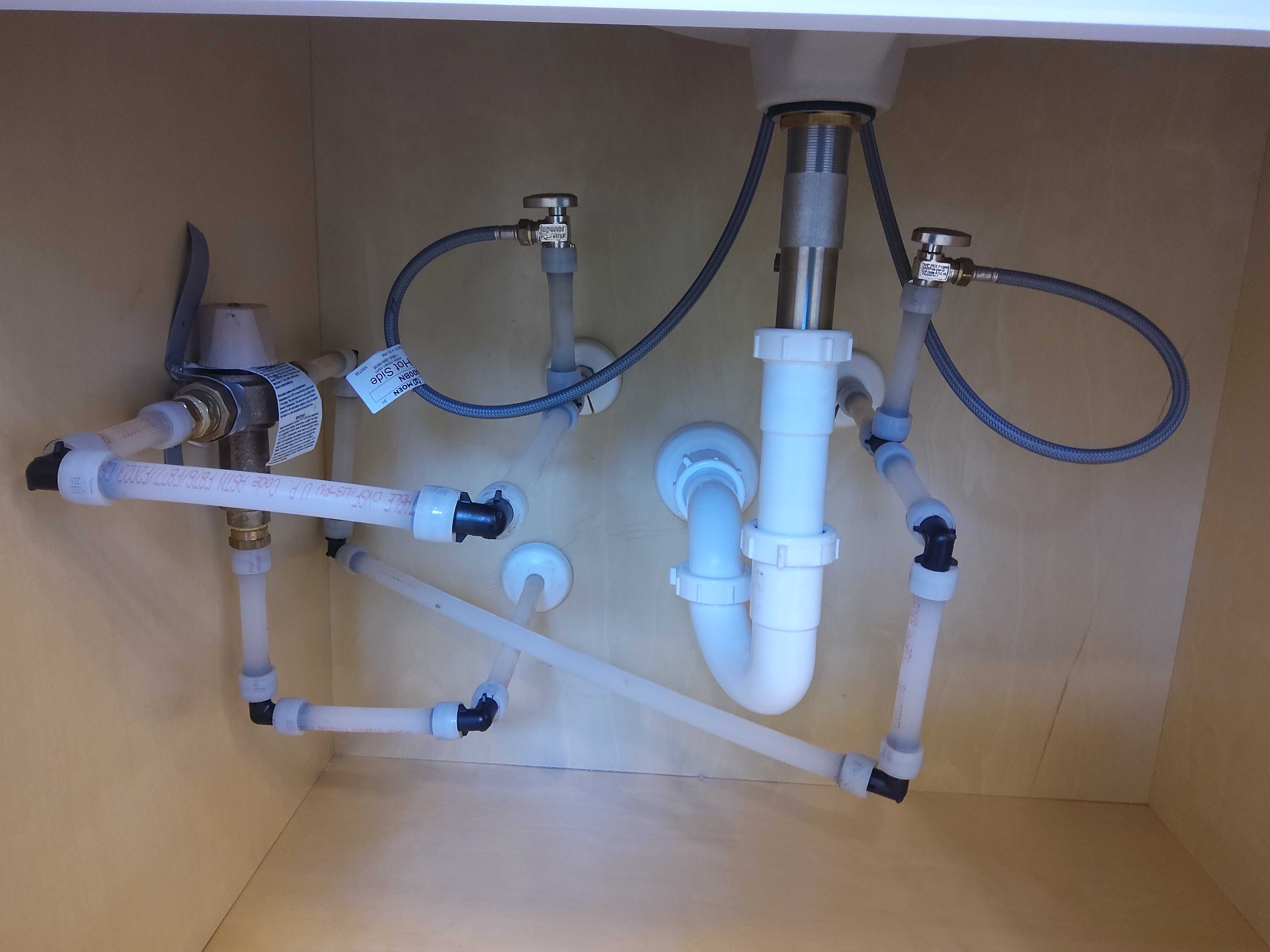Hi all.
Just did an inspection on a new construction house. The house was plumbed with pex.
In the master bathroom under vanity sink I saw a cluster of pex and wanted to get your opinions on what you all thought and if you would mention this in the report and what would you say.
I believe the valve is a pressure reducing/regulating valve. The two pipes on the left of the p-trap are hot water and the one on the right of the p-trap is cold water.
The other side of the wall where the pipes go through is the laundry room.
Let me know your thoughts.
Thanks
It’s most likely a thermostatic valve to lower the water temperature for the bathtub.
Mixing valve feeds the toilet so it doesn’t sweat is my take.
I did that in my house and it worked great… ![]()

I don’t understand why they don’t run the pipes so the have optimum storage space under there…yes I do… ![]()
Lack of talent or he had no F**ks left to give ![]()
And you can bet people will still try to store things leaving a good chance of some fittings getting popped loose.
Thermostatic mixing valve to regulate high hot water temperature to prevent scalds.
Pretty poor use of space under the sink. The cold water line could have been run at the back of the cabinet. All the piping could have been install at the back of the cabinet.
Although not required, water hammer arrestors and leak detection sensors are great add-ons and reduce insurance premiums at times.
I would say nothing. It’s a normal installation without a defect so why would you report on it? I only report defects but do as you wish. Marcel had the likely correct answer.
Thanks for all the replies.
I don’t know why they would need that for the toilet, house is in Florida. I have never seen that for the toilet. Also 3 pipes connected to the valve. 2 hot and one cold.
As for scalding, this is only by the one sink in the master bathroom, nothing by the second sink on the adjacent wall.
I never did put it in the report as a defect but did show the client the cluster and suggested that he has the builder neaten things up a bit. I also feel that it just wasted all the space under the sink. I also feel that it is a leak waiting to happen. Someone is definitely going to knock one of those pipes and bust the fitting.
If/When 32" inch support rule not in play call it out. Cold water line I suspect.
Suspect: Poor pipe support and clearance.
Poor use of space.
Refer to a licensed plumbing contractor for further review.
Although not required, water hammer arrestors and leak detection sensors are great add-ons and reduce insurance premiums at times.
That space beneath the sink is being used for exactly what the space is intended for… plumbing components!
None of that other crap we usually see was ever meant to be there.
It’s actually a potential health hazard!
Do you have pictures of the fixtures in this bathroom ? what faucets, etc… are installed?
The valve on the left is a temperature regulating valve (thermostatic mixing valve) for the stand alone tub in the master. Tubs typically have no method to regulate hot water temperatures at and below 120 Degrees. It is common to place them under sinks in new construction. There are other locations they can be placed to prevent the mess seen here.
It is a piss poor positioning of piping as it does leave them susceptible to damage which is one thing I do add to reports. If you want you can also mention the valve control handle is not fully accessible. If you want to take it one step further you can look at the PEX manufacturer installation requirements to ensure all piping and joints are properly supported.
Good thorough post, Emmanuel. Codos.
Technically correct. Aesthetically, WTF! If I was the buyer of that new construction, I would not be pleased.
Emmanuel’s post above covers it very well. These became required in Oregon +/- 10 years ago and are usually under the sink but sometimes in other areas. I don’t comment other than to explain to the buyer what/why it’s there.
Along these lines something I always check for in new construction is water temp coming from the tub/showers with mixing valves. It’s common for the plumbers to leave them producing ridiculously low temp hot water (still being blended with some cold). It’s nothing that we’d ever get sued over but you can definitely save your buyers a hassle and annoyance of no hot shower on moving day.
to be fair a couple of those horizontal runs would be great places to dry wet wash cloths…
Manny, we had just warm water at our tubs in our house when we bought it. So, I took the handle off and adjusted the plastic knurled disc in there to raise the temperature to what we like (we typically have no people use the tubs that cannot cope with the hotter temperature that the valves come from the factory adjusted for code-wise, which is ~120 degrees). One can adjust the water to less than 120 degrees also…if desired.
I don’t know how long it has been mandated like that but it has been years around here…did you know that? I think a top notch inspector like you would be aware of that.

